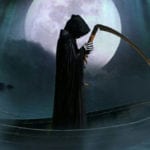 Music
Music  Music
Music  History
History 10 Less Than Jolly Events That Occurred on December 25
 Weird Stuff
Weird Stuff 10 Funny Ways That Researchers Overthink Christmas
 Politics
Politics 10 Political Scandals That Sent Crowds Into the Streets
 Weird Stuff
Weird Stuff Ten Bizarre Facts About The Doge Meme
 Our World
Our World 10 Ways Your Christmas Tree Is More Lit Than You Think
 Movies and TV
Movies and TV The 10 Coolest Stars to Set Sail on The Love Boat
 History
History 10 Things You Didn’t Know About the American National Anthem
 Technology
Technology Top 10 Everyday Tech Buzzwords That Hide a Darker Past
 Humans
Humans 10 Everyday Human Behaviors That Are Actually Survival Instincts
 Music
Music 10 Surprising Origin Stories of Your Favorite Holiday Songs
 History
History 10 Less Than Jolly Events That Occurred on December 25
 Weird Stuff
Weird Stuff 10 Funny Ways That Researchers Overthink Christmas
Who's Behind Listverse?

Jamie Frater
Head Editor
Jamie founded Listverse due to an insatiable desire to share fascinating, obscure, and bizarre facts. He has been a guest speaker on numerous national radio and television stations and is a five time published author.
More About Us Politics
Politics 10 Political Scandals That Sent Crowds Into the Streets
 Weird Stuff
Weird Stuff Ten Bizarre Facts About The Doge Meme
 Our World
Our World 10 Ways Your Christmas Tree Is More Lit Than You Think
 Movies and TV
Movies and TV The 10 Coolest Stars to Set Sail on The Love Boat
 History
History 10 Things You Didn’t Know About the American National Anthem
 Technology
Technology Top 10 Everyday Tech Buzzwords That Hide a Darker Past
 Humans
Humans 10 Everyday Human Behaviors That Are Actually Survival Instincts
Top 10 Irish Songs with Strange Origins
For decades, people have traveled from all around the world to kiss the Blarney stone and visit Grafton Street. And one of the most precious souvenirs they take away is the memory of Irish folk songs ringing in their ears and the memory of a stiff drink.
The music from this enchanted island swirls around centuries of love and war, feast and famine. It tells the story of bravery, cowardice, death, and experiencing life the way it was meant to be lived. Of course, there are a few with some pretty unique backgrounds. So here are the top 10 Irish songs with strange origins.
Related: Top 10 Fascinating Stories Behind The Lyrics Of Popular Songs
10 “Molly Malone”
Oh, sweet Molly Malone. She was just trying to sell her fish at the market. Although, maybe that’s a lot less appropriate than we thought.
There’s nothing conclusive that talks about “Molly Malone” being based on an actual person, but that doesn’t mean that the classic song hasn’t memorialized her into something real. Supposedly, she was a sexy fishmonger (I guess that’s a thing?) who worked in Dublin. Another record found in the 1790s book Apollo’s Medley really leans into the sex appeal aspect. It hints she worked a second shift as a prostitute when the fish were gone. I guess that gives the term “streetwalker” a whole new meaning.
After dying from a fever, her ghost was said to haunt the fair city.
While there are actually a lot of Malones floating around Ireland, one Mary Malone (Molly is sometimes a nickname for Mary) was thought to have been the real-life lady. She apparently died in 1699. And Dublin has all but adopted Miss Malone, giving her a holiday of her own (June 13th) and a busty bronzed statue.
9 “The Fields of Athenry”
It’s no secret that the Irish Famine is a pivotal period in the country’s long history. So when songwriter Pete St. John heard about the struggles of the time while staying in Galway, he penned a tribute that would make Athenry famous. While the family in the song is fictional, the situation they faced was anything but.
Apparently, Indian corn was sent from the U.S. to help the Irish people. But it was completely unusable because the kernels were too hard for the Irish mills. Hungry and outraged, Irish people stormed the city and were arrested, then sent to Australia for prison. And thanks to the ballad “The Fields of Athenry,” Indian corn made an important impact on the history of European football. Let’s discuss.
This powerful song about the Irish famine was considered a team anthem. During the 2012 European Football Championship, the Irish team had lost brutally. But the crowd began singing to their team in a chorus so moving that commentators were asked to zip it so everyone could hear.
8 “Carrickfergus”
Made into a classic by none other than Van Morrison, this is one song that only makes partial sense. But there are a lot of clues in “Carrickfergus” that piece together a strange story…and it just might connect back to ancient Greece.
One of the weirdest issues with the song’s mysterious history is the fact that it seems to switch back and form between Carrickfergus and Ballygrant—two towns that are separated by the Irish Sea. Some people claim that the lyrics may have played a little telephone over time, specifically by actor Peter O’Toole.
However, the song talks about not being able to swim across the wide sea and searching for a handsome boatsman to “ferry me over to my love and die.” Now here’s where it starts to get Greek. In ancient mythology, a boatman would ferry dead souls into the Underworld over the River Styx. All this suggests that the old man in the song wasn’t just getting close to death. He longed to be buried across the sea in Scotland (Ballygrant), where his love was likely buried.
7 “The Galway Girl”
Alright, now this is one Irish dame who’s 100% real—we swear on our mashed potatoes.
“The Galway Girl,” a modern folk song from the Emerald Isle, was written in 2000 by Steve Earle. He recorded it alongside Sharon Shannon. While the two met in Galway, she is definitively not the long-lost lover from the song.
Before Shannon and Earle met, he met a little lass who stole his heart and inspired this hit. And, apparently, they’re still friends. And that may have been all they ever were. Though Shannon has hinted that they still spend platonic time together, and mutual friends have reported the tension between the two is crazy.
But just like the black-haired beauty from the song, she likes to leave a little mystery. She prefers to stay anonymous, apparently. “And I ask you, friend, what’s a fella to do?”
6 “Arthur McBride”
The song “Arthur McBride” is also definitely a shift from the traditional Irish ballad too. While half of all classic folk songs are about going to war or coming home from war, this one is actually about resisting war. Despite the fact that this was written in the 1800s, it almost sounds more like a 1970s protest song.
The exact war that inspired this song is unknown, but many speculate that it’s either the Napoleonic Wars or the Williamite War—especially since the song talks about soldiers being sent to France. Historians believe the story took place in Donegal based on the origins of the name McBride. But if I’m being totally honest, the best tidbit of strange with this poem comes at the end. After two recruiters attempt to talk a man and his cousin into war, they shut him down, bash them over the head, and then literally drop-kick their stuff into the ocean.
5 “Finnegan’s Wake”
So this title has been a best-selling book and a quirky film. But it was originally an Irish comedy song. The weird ballad is about a whiskey-obsessed brock hod who needs to toss a couple back before work every morning.
Or at least he did until he falls off a ladder and dies. Comedy gold, right? Hang with me. At his wake, everybody’s drinking more whiskey, and they start fighting (talk about stereotypes…). But when they accidentally spill their booze on the corpse, it springs the old man back to life.
If we’re being honest, this story is kind of ridiculous. But the best part is that it inspired James Joyce’s last book of the same title in 1939. So this over-the-top sloppy drinking song became immortalized as one of the most influential pieces of literature in history.
4 “Noreen Bawn”
If you haven’t noticed yet, there are quite a few Irish songs named after women. Gee, I wonder why. But this one isn’t your typical across-the-sea love song. It was actually written about Bridget Gallagher.
Gallagher was an Irish songbird who was buried in Doe Cemetery in Creeslough, where she was originally from. Known by her fans as “The Girl from Donegal,” she was a record-holder for drawing thousands to her show at London’s Albert Hall.
3 “Wild Mountain Thyme”
While the origins of this song aren’t exactly strange, they’re kind of confusing. It’s hard to tell who the real author is. Apparently, it was originally based on a song by poet Robert Tannahill titled “The Braes of Balquhither.” But also, it was totally different.
Then it was adapted by Francis McPeake into the song we know today—almost. He wrote the song for his wife. Then, his son added a verse when Francis remarried. Finally, his nephew recorded the song. But he apparently tried to claim some credit for writing it as well. It sounds like too many cooks in the kitchen for this Irish stew.
2 “The Sash”
How about a war song about a colorful wardrobe? Yup, that’s pretty strange, alright. The song “The Sash” was an original folk song for loyalists that many believe was about the Jacobite siege of Derry in the 17th century.
Also called “The Sash My Father Wore,” it literally centers around an orange sash. These sashes were part of the Protestant uniform, signifying victory. Today, it’s considered a popular tune for marching bands.
1 “On Raglan Road”
Now this song has a strange and kind of hilarious background story. It was based on a 1946 poem by Patrick Kavanagh and is at least partially accurate.
In the poem “Dark Haired Miriam Ran Away,” he meets a girl on the street and decides to hit on her, despite knowing he’ll probably end up hurt. But apparently, the name Mirium was a cover for his actual girlfriend, Dr. Hilda Moriarty. Is it just me, or does she sound like a Sherlock Holmes villain?
Still, she inspired his famous poem (since the two would meet on Raglan Road) and several others creatively named Hilda, Hilda 2, Hilda 3, and so on.
But in the end, Kavanagh was right—they wouldn’t make it. Moriarty stated later that the biggest problem was their 18-year age difference. Can’t say I blame her on that one.








